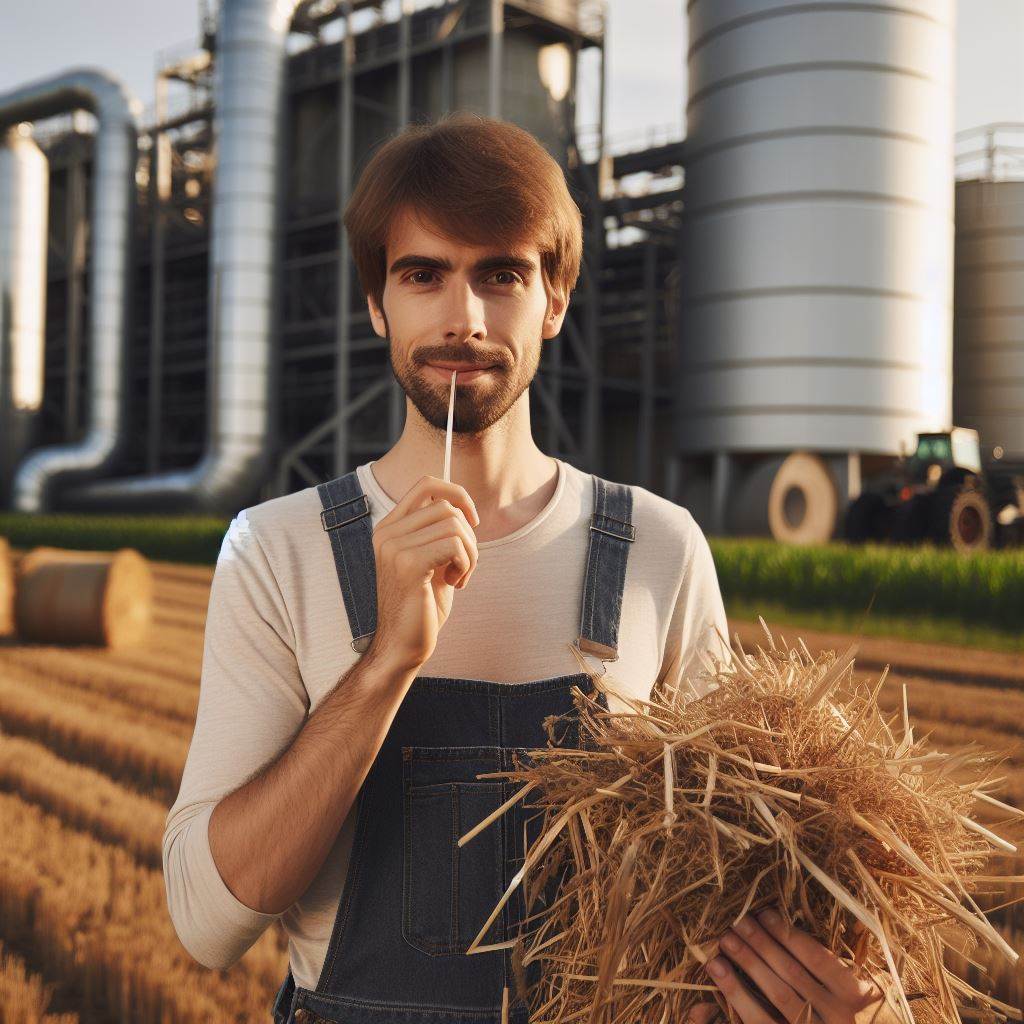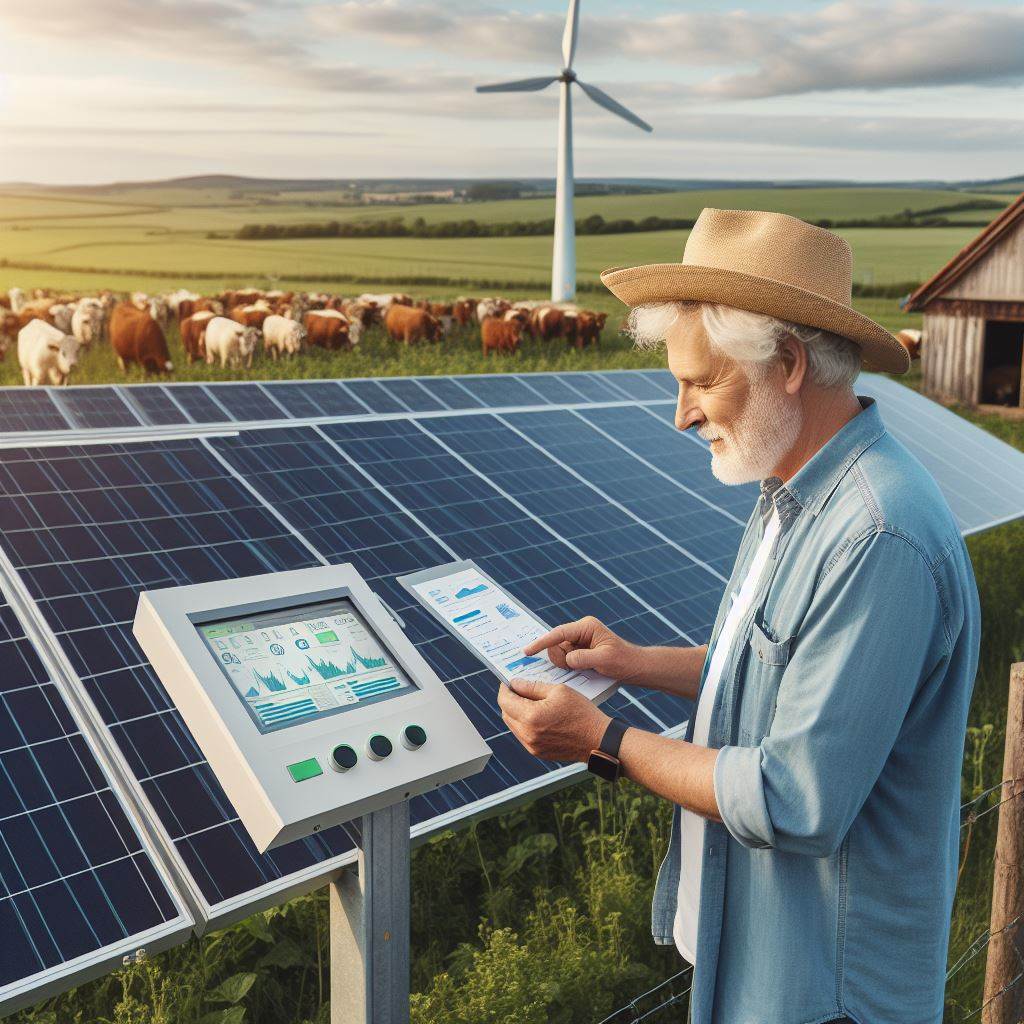Introduction
Biomass is defined as organic matter derived from plants and animals.
Renewable resources are vital for sustainable farming practices.
As we delve into the rich tapestry of biomass, it becomes evident that this renewable resource transcends mere energy production, becoming a cornerstone for holistic farming ecosystems.
From crop residues to organic waste, biomass harnesses the essence of circularity, converting byproducts into a source of vitality.
Its versatility extends beyond energy, finding applications in soil enrichment, carbon sequestration, and even the creation of bio-based materials.
With an ever-growing emphasis on sustainability, biomass emerges as a catalyst for a regenerative agricultural paradigm, fostering resilience against environmental challenges.
This exploration unfolds the myriad facets of biomass, weaving a narrative that underscores its transformative potential in shaping a greener, more sustainable future for farming and beyond.
Benefits of Biomass in Farming
Reduction of greenhouse gas emissions
Biomass farming plays a crucial role in reducing greenhouse gas emissions, contributing to a cleaner environment.
By utilizing organic materials for energy production, such as crop residues or animal manure, farmers can reduce the reliance on fossil fuels.
The combustion of biomass generates carbon dioxide, but since the plants absorbed this carbon dioxide during their growth, it is considered carbon neutral.
Enhancement of soil fertility
Biomass farming provides organic matter that can be used as a soil amendment, enriching its fertility.
Crop residues and green manure are commonly used to improve soil structure, moisture retention, and nutrient availability.
The addition of biomass to the soil enhances microbial activity, promoting healthy soil ecosystems and reducing the need for chemical fertilizers.
Diversification of income streams
Biomass farming offers farmers additional income opportunities beyond traditional crop production.
By cultivating energy crops like switchgrass or miscanthus, farmers can sell biomass as a raw material for biofuel production or as feedstock for biogas plants.
Transform Your Agribusiness
Unlock your farm's potential with expert advice tailored to your needs. Get actionable steps that drive real results.
Get StartedThese alternative income streams can provide stability and flexibility, reducing the financial risks associated with fluctuating crop prices.
Utilization of waste materials
Biomass farming effectively addresses waste management issues by efficiently utilizing various waste materials.
Agricultural residues and by-products, such as straw, corn stalks, or fruit peels, can be transformed into valuable biomass resources.
Instead of being discarded, these waste materials are repurposed for energy generation, reducing landfill waste and minimizing environmental pollution.
In short, biomass farming brings several notable benefits to the agricultural sector.
By reducing greenhouse gas emissions and enhancing soil fertility, it contributes to a more sustainable farming practice.
Additionally, the diversification of income streams and the utilization of waste materials provide economic and environmental advantages.
Overall, the adoption of biomass farming techniques is a promising step towards a greener and more resilient agricultural industry.
Read: Wind Power Impact on Agriculture
Types of Biomass in Farming
Crop residues
Crop residues are a significant type of biomass in farming, referring to the leftover stalks, leaves, and husks after harvest.
Farmers often utilize crop residues through various methods such as ploughing them back into the soil or utilizing them as animal feed.
The advantages of using crop residues include enhancing soil fertility, reducing erosion, and providing organic matter for the soil.
However, it is important to manage crop residues effectively to prevent nutrient loss and pest infestations.
Animal waste
Animal waste, such as manure, is another type of biomass commonly found in farming practices.
Farmers can collect and store animal waste, then use it as a natural fertilizer for their crops, promoting healthy growth and reducing the need for chemical fertilizers.
Furthermore, anaerobic digestion of animal waste produces biogas, a renewable source of energy that can be used for electricity and heat generation.
Energy crops
Energy crops, also known as dedicated energy crops, refer to specific plant species cultivated exclusively for biomass production.
These crops, including switchgrass, miscanthus, and willow, have high energy content and can be converted into fuels such as ethanol or utilized in biopower plants.
Energy crops serve as a renewable alternative to fossil fuels, contributing to a reduction in greenhouse gas emissions.
Furthermore, these crops can be grown on marginal lands, minimizing competition with food crops for arable land.
Algae
Algae, often found in water bodies, are a unique type of biomass that can be cultivated for various purposes in farming.
With high growth rates, algae can be an abundant source of biomass for biofuel production, animal feed, and even nutritional supplements.
The cultivation of algae also provides additional benefits, such as wastewater treatment, carbon dioxide absorption, and nutrient recycling.
Moreover, algae-based systems can operate in areas where traditional agriculture faces limitations, such as water scarcity or poor soil quality.
Showcase Your Farming Business
Publish your professional farming services profile on our blog for a one-time fee of $200 and reach a dedicated audience of farmers and agribusiness owners.
Publish Your ProfileIn fact, biomass in farming includes crop residues, animal waste, energy crops, and algae, each offering unique advantages and possibilities.
By utilizing these types of biomass, farmers can contribute to sustainable agriculture, reduce dependency on fossil fuels, and promote a cleaner environment.
Through proper management and advanced technologies, biomass in farming can become a significant renewable resource with multiple economic and environmental benefits.
Read: Solar Energy: Changing Agriculture
Biomass Conversion Technologies
Combustion
One of the most common methods of converting biomass into energy is through combustion.
Combustion involves burning biomass in a controlled manner to produce heat, which can then be used to generate electricity or provide heat for various applications.
Biomass fuels such as wood, straw, or agricultural residues are typically burned in specialized boilers or furnaces designed for efficient combustion.
The heat generated from the combustion process is then used to produce steam, which can drive a turbine connected to a generator to produce electricity.
In addition to electricity generation, combustion can also be used for space heating and industrial applications.
Anaerobic digestion
Another effective biomass conversion technology is anaerobic digestion.
Anaerobic digestion involves breaking down organic matter, such as manure or food waste, in the absence of oxygen.
This process produces biogas, which mainly consists of methane and carbon dioxide.
The biogas can be captured and used as a renewable source of energy.
Anaerobic digestion has various applications, including generating electricity, producing heat, and producing biofuels such as biogasoline or biodiesel.
Furthermore, the byproduct of anaerobic digestion, called digestate, can be used as a fertilizer in agriculture.
Gasification
Gasification is another biomass conversion technology that utilizes high temperatures and limited oxygen to convert biomass into a synthesis gas, or syngas.
Syngas is a mixture of carbon monoxide, hydrogen, and other combustible gases.
This syngas can then be used as a fuel for engines or turbines to generate electricity or heat.
Gasification has the advantage of being able to convert a wide range of biomass feedstocks, including wood, agricultural residues, and energy crops.
It is also a versatile technology that can be used in small-scale decentralized systems as well as larger-scale power plants.
Pyrolysis
Pyrolysis is a thermal decomposition process that converts biomass into biochar, bio-oil, and syngas.
During pyrolysis, biomass is heated in the absence of oxygen, which leads to the production of these valuable products.
Biochar is a carbon-rich solid that can be used as a soil amendment to improve soil fertility and sequester carbon.
Bio-oil, on the other hand, can be further upgraded and used as a renewable fuel for heat and power.
Syngas produced during pyrolysis can be used as a fuel for electricity generation or as a precursor for the production of various chemicals and fuels.
In essence, biomass conversion technologies play a crucial role in harnessing the potential of biomass as a renewable resource.
Combustion, anaerobic digestion, gasification, and pyrolysis offer different pathways to convert biomass into energy.
These technologies not only help reduce greenhouse gas emissions but also provide opportunities for decentralized energy production and sustainable agricultural practices.
By utilizing biomass conversion technologies, we can take advantage of farming’s renewable resource and move towards a more sustainable and greener future.
Read: Eco Farming: Harnessing the Sun Power
Challenges and Solutions in Biomass Farming
Logistics and Transportation
- Transporting biomass from farms to processing facilities can be costly and logistically challenging.
- Solutions include establishing collection points and improving transportation infrastructure for efficient biomass delivery.
- Utilizing advanced technology like GPS tracking and automated logistics systems can optimize transportation routes.
- Collaboration between farmers and transport companies can help overcome logistics challenges in biomass farming.
- Streamlining supply chain processes and implementing efficient scheduling systems can improve transportation efficiency.
Storage and Handling
- Proper storage of biomass is crucial to maintain its quality and prevent degradation.
- Using suitable storage facilities such as silos, warehouses, and covered areas can protect biomass from environmental factors.
- Implementing appropriate handling techniques like drying, shredding, and baling can enhance storage efficiency.
- Incorporating effective inventory management systems can ensure proper handling and prevent waste.
- Regular maintenance and monitoring of storage facilities can prevent issues like pest infestation or moisture damage.
Financial and Technical Barriers
- Biomass farming requires significant initial investment for equipment, infrastructure, and operations.
- Accessing financing options like loans or grants tailored for renewable energy projects can address financial barriers.
- Gaining technical expertise and knowledge through training programs and strategic partnerships can overcome technical challenges.
- Government incentives and policies promoting biomass farming can help reduce financial barriers and encourage industry growth.
- Engaging with experts, consultants, and industry associations can provide valuable guidance in navigating financial and technical obstacles.
Collaboration and Knowledge Sharing
- Collaboration among farmers, researchers, and industry stakeholders is vital for overcoming challenges in biomass farming.
- Creating platforms for knowledge sharing, such as workshops, conferences, and online forums, promotes innovation and problem-solving.
- Establishing partnerships between farms and research institutions can drive advancements in biomass farming techniques.
- Sharing best practices and success stories across the industry can inspire and guide others in overcoming their own challenges.
- Encouraging open dialogue and fostering a supportive community can strengthen the collective knowledge in biomass farming.
In general, biomass farming faces various challenges, but solutions exist to overcome them.
Improving logistics and transportation, implementing proper storage and handling practices, addressing financial and technical barriers, and fostering collaboration and knowledge-sharing are crucial steps towards a sustainable and efficient biomass farming industry.
By tackling these challenges head-on, the renewable resource potential of biomass can be harnessed to support agricultural communities and contribute to a greener future.
Read: Sun, Wind, Soil: Farming’s Future

Case Studies on Successful Biomass Farming
In this section, we will take a closer look at three case studies that highlight the successful implementation of biomass farming practices.
These case studies demonstrate the various ways in which biomass can be utilized as a renewable resource in farming.
Quad County Corn Processors, USA: Utilizing Crop Residues for Biomass Energy Production
Quad County Corn Processors is a bio-refining company located in the United States that has successfully implemented biomass farming practices.
They specifically focus on utilizing crop residues for biomass energy production.
By partnering with local farmers, Quad County Corn Processors collects and processes crop residues such as corn stalks, wheat straw, and soybean stems.
These agricultural waste materials are then converted into biofuels, such as ethanol, through a fermentation process.
Showcase Your Farming Business
Publish your professional farming services profile on our blog for a one-time fee of $200 and reach a dedicated audience of farmers and agribusiness owners.
Publish Your ProfileThis innovative approach not only provides an additional source of income for farmers but also reduces the amount of agricultural waste that would otherwise be left unused.
It contributes to the production of renewable energy, reducing reliance on fossil fuels.
Fair Oaks Farms: Implementing Anaerobic Digestion to Convert Animal Waste into Biogas
Fair Oaks Farms, located in the United States, is a dairy farm that has successfully implemented anaerobic digestion technology to convert animal waste into biogas.
Through anaerobic digestion, the farm collects and processes manure from its dairy cows.
The manure is then placed in an airtight digester, where naturally occurring bacteria break down the organic matter and produce biogas, primarily composed of methane.
This biogas is then captured and used as a renewable energy source. It can be utilized for heating, electricity generation, or as a transportation fuel.
By converting animal waste into biogas, Fair Oaks Farms not only reduces greenhouse gas emissions but also creates an additional revenue stream.
Prairie Power, Inc.: Cultivating Energy Crops for Biomass Feedstock
Prairie Power, Inc. is a company that focuses on cultivating energy crops specifically for biomass feedstock.
Located in a rural area, their primary goal is to provide sustainable and renewable energy to the local community.
They strategically plant energy crops such as switchgrass, miscanthus, and giant reed, which are fast-growing and rich in cellulose.
These crops are then harvested and converted into biomass feedstock, which can be used for various applications, including electricity generation and biofuel production.
By cultivating energy crops, Prairie Power, Inc. not only contributes to the production of renewable energy but also creates local economic opportunities.
They partner with local farmers, providing them with an additional source of income while helping the community become more self-sufficient in terms of energy.
These case studies highlight the diverse ways in which biomass farming can be implemented successfully.
Whether through utilizing crop residues, converting animal waste into biogas, or cultivating energy crops for biomass feedstock, these practices demonstrate the potential of biomass as a renewable resource in farming.
Implementing such practices not only contributes to sustainable agriculture but also reduces dependence on non-renewable energy sources, mitigates climate change, and promotes local economic development.
This showcases the importance of embracing biomass farming as a viable and environmentally friendly solution for the future of agriculture.
Government Support and Policies for Biomass Farming
The growth and development of the biomass farming industry has been significantly influenced by government support and policies.
In order to promote the use of renewable resources and reduce dependency on fossil fuels, various incentives, grants, programs, initiatives, and international agreements have been established.
Federal Incentives and Grants
- Federal government offers incentives and grants to encourage biomass farming practices.
- These incentives include tax credits, subsidies, and loan guarantee programs.
- Grants are provided to support research, innovation, and the establishment of biomass farming infrastructure.
- These programs aim to stimulate investment, boost job creation, and enhance sustainable agricultural practices.
- By providing financial assistance, the government aims to make biomass farming more economically viable.
State-level Programs and Initiatives
- State governments play a crucial role in promoting biomass farming within their jurisdictions.
- Many states have established programs and initiatives to support the growth of the industry.
- These programs provide funding for biomass crop cultivation, processing facilities, and distribution networks.
- State governments also offer technical assistance, training, and education to farmers and entrepreneurs entering the biomass sector.
- By collaborating with universities, research institutions, and industry stakeholders, states aim to develop sustainable biomass farming practices.
International Agreements and Targets
- Various international agreements and targets have been set to promote the use of biomass resources globally.
- The United Nations Framework Convention on Climate Change (UNFCCC) encourages countries to reduce greenhouse gas emissions through sustainable agricultural practices.
- Under the Paris Agreement, countries have committed to limiting global warming by transitioning to renewable energy sources.
- International targets such as the Sustainable Development Goals (SDGs) emphasize the importance of bioenergy in achieving sustainable development.
- These agreements and targets provide a framework for governments to develop policies and provide financial support for biomass farming.
In a nutshell, government support and policies play a vital role in promoting the growth of biomass farming.
Federal incentives and grants, state-level programs and initiatives, and international agreements and targets all contribute to the development of a sustainable and economically viable biomass industry.
By providing financial assistance, technical expertise, and creating a favorable regulatory environment, governments aim to accelerate the transition to renewable energy sources and reduce the environmental impact of agricultural practices.
As biomass farming continues to evolve, it is essential for governments to continue supporting the industry’s expansion and innovation.
Conclusion
Biomass in farming offers numerous benefits, including improved soil health, reduced waste, and cost-effective energy production.
To maximize their agricultural productivity and income, farmers should consider exploring the opportunities in biomass farming.
It is crucial to emphasize the role of biomass in sustainable agriculture and its significant contribution to combating climate change.
By adopting biomass farming practices, farmers can make a positive impact on the environment.




